
PDF Publication Title:
Text from PDF Page: 022
Mapping of global plastics value chain and plastics losses to the environment With a particular focus on marine environment 2017; Essel et al., 2015; Jambeck et al., 2015; Lassen et al., 2015; Magnusson et al., 2016; Sundt et al., 2014) were used to identify the main sources of losses. With regards to the sources of losses found in the previous studies, the methodologies applied in those studies as well as new models specifically made for this study were used to derive global estimates of plastic losses (described under the relevant section in Chapter 6). The models derived in this study, for instance includes modelling of treatment of wastewater and microplastics removal efficiency, and modelling of generation of municipal solid waste and treatment of the solid waste. Indeed, a number of assumptions were necessary to derive global estimates of plastic losses along the full plastics value chain, for instance, extrapolation of regional data to global scale. Hence, the data used, calculations, and choices for deriving global estimate in this study are provided in the report and described when first used. It needs to be stressed that this report only provide an indication of the total global losses and that these estimates comes with a large degree of uncertainty. To reduce this uncertainty, more specific information is needed. For instance, specific data on waste treatment were not available at an aggregated level and such data is likely only available at local levels. Obtaining data at such high resolution for all processes for which plastics are lost was not within the scope of this project. Nevertheless, this study provides a realistic estimate of the global losses and a very valuable result of this project is to identify the main sources of plastic losses. This allows for focusing on retrieving detailed data for processes which are actually relevant in terms of plastic losses, thereby avoiding focusing on getting very detailed data for processes that in the bigger picture do not contribute significantly to the problem of marine plastic. | Comparison of losses with findings of plastics in marine environment and potential impact on marine environment To get an idea about the plastic types lost to the environment which actually reach the marine environment, the estimated losses to the environment were compared with retrieved information about the primary plastic types found in marine environment (Chapter 7). This comparison between the estimated losses and reporting of plastics in the ocean was done because it was not possible to estimate the share of the plastics lost to the environment that are eventually lost to the marine environment. However, in this way, it was possible to indicate the plastic losses actually ending up in the ocean and, therefore, indicate which sources of plastic losses to focus on with regard to reducing losses to the oceans. The information on findings of plastics in the marine environment does not provide complete coverage of all plastics found in the marine environment. However, it does provide a good indication of the main types of plastics, thereby, allowing better understanding of the most important losses. The mass of macro- and microplastics released to the oceans are not an appropriate indicator of impacts, as it does not reflect the actual damages to the environment. Hence, information on the potential impacts on marine environment of different macro- and microplastics was retrieved to facilitate an assessment of the most problematic plastic losses from the value chain and findings of plastics in the marine environment (see Chapter 8). Although, a complete understanding of the impacts of micro- and macroplastics on the marine environment is still lacking, we base this indication on scientifically based literature on the potential impacts of micro- and macroplastics on the marine environment. This allows for indicating which types of plastic are most problematic and, thus, which losses that should be reduced. 20 | 1 IntroductionPDF Image | Mapping of global plastics value chain

PDF Search Title:
Mapping of global plastics value chainOriginal File Name Searched:
2018-plastics-global-hotspots.pdfDIY PDF Search: Google It | Yahoo | Bing
Development of a solar powered Electric Ship The Electricship website originally started off as a project to develop a comprehensive renewable, affordable, modular electric ship... More Info
Modular Boat Hull Composite The case for a unsinkable, modular composite hybrid boat hull... More Info
MS Burgenstock Hybrid Electric Catamaran Lake Lucerne Unique shuttle servicing Lucerne to the Burgenstock Resort... More Info
Ground Power Unit GPU Powered by Lithium Ion Batteries The goal of the Ground Power Unit is to provide a readily accessible, modular, ready-to-power solution for remote power... More Info
| CONTACT TEL: 608-238-6001 Email: greg@electricship.com | RSS | AMP |